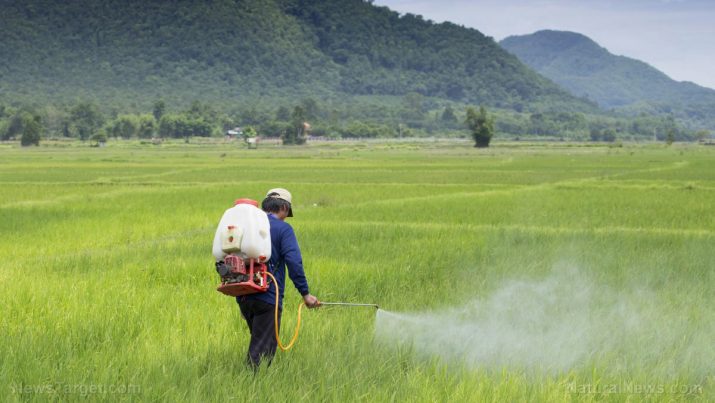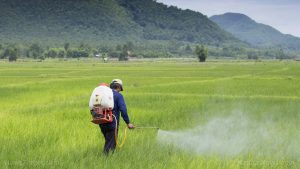
Hexazinone — toxicity, side effects, diseases and environmental impacts
Thursday, November 23, 2017 by Jhoanna Robinson
http://www.naturalpedia.com/hexazinone-toxicity-side-effects-diseases-and-environmental-impacts.html

Hexazinone, which has the trade names Velpar, Brushkiller and DPX 3674, is a white crystalline solid tirazine herbicide that is mostly used on non-crop areas and to control the weeds that sprout near lucerne, pineapples, and sugarcane. It works by halting the process of photosynthesis in many annual, biennial, and perennial weeds as well as some woody plants. Rainfall or water irrigation is necessary to achieve the full potent effects of this herbicide.
Hexazinone is produced by reacting cyanoamine with methyl chloroformate, and then by treating the resultant product with dimethylamine and cyclohexyl isocyanate. Other triazine herbicides include atrazine, hexazinone, metribuzin, prometon, prometryn, and simazine. They inhibit aliphatic amino acid synthesis in plants. This amino acid does not exist in mammals, and as such, hexazinone has little toxic effects to mammals.
List of known side effects
Hexazinone is known to irritate the nose and throat of humans. It is toxic to larch trees and should not be used to control vegetation in a forested area. It is also toxic to fish and other aquatic creatures. These are the respective fishes that are affected by hexazinone, as well as the equivalent value of hexazinone that can poison them: rainbow trout (320 parts per million), fathead minnow (274 ppm), and bluegill (370 ppm).
Hexazinone is bad for the skin. It can cause cyanosis, and sweating. Other side effects of hexazinone exposure are anorexia, salivation, fasciculations (a brief, spontaneous muscle contraction affecting a small number of muscle fibers), ataxia (the loss of full control of bodily movements), and increased body temperature.
Hexazinone also exacerbates the condition of people who have acidosis, cardiovacular toxicity, and severe gastrointestinal symptoms.
Body systems affected by hexazinone
Hexazinone is bad for the ocular system. It has a very low toxicity but it carries the Danger-Warning sign because it can give extremely bad eye irritations.
Hexazinone is bad for the digestive system. It can cause diarrhea and vomiting and esophageal and gastric injury.
Hexazinone is bad for the excretory system. Exposure to it can lead to liver damage by causing the influx of hepatocellular adenomas and carcinomas, liver hypertrophy, and focal necrosis. It can also cause renal failure.
Hexazinone is bad for the circulatory system. It can cause disseminated intravascular coagulation that can further lead to inducement of coma. It can even give rise to hypotension and heart block.
Hexazinone is bad for the central nervous system. It can cause seizures.
Hexazinone is bad for the respiratory system. It can give rise to chest x-ray abnormalities, dyspnea or difficulty in breathing, and lung injury.
Hexazinone is bad for the endocrine system. It can cause hyperthyroidism, and it interferes with the hypothalamic control of the pituitary-ovarian glands.
Items that can contain hexazinone
Hexazinone is a herbicide that has been found to cause significant harmful effects to human and aquatic life.
How to avoid hexazinone
Take care not to let hexazinone form dust patterns on a surface, as this could be the start of the spread of contamination. Take care to avoid breathing in mists or vapors from the chemical by wearing adequate protective clothing whenever handling this herbicide – this includes protective gloves and a good-fitting mask.
Also, take care not to let it spill or seep through waterways. Remove ignition sources from the place where you store hexazinone.
If you are in the business of handling hexazinone, remember to always wash your hands during the workday – after handling the product and in between breaks – so as to eradicate the chances of contamination. Remove your gloves using proper glove removal technique, which is to say without touching the glove’s outer surface. Dispose of contaminated gloves properly.
Long sleeved- shirts and long pants should be worn when handling the herbicide. Protective eyewear, shoes, and socks are also a must.
Wash your skin at the very instant that hexazinone touches it. Exhausts should be put to work whenever there are instances of hexazinone dispersion in the work area.
Where to learn more
- Hawaii’s Department of Agriculture sued for dumping hazardous pesticides into waterways
- Poison gas leak kills DuPont worker
- Smoking plastic, pesticide, bleach and fiberglass – The four killers that Big Tobacco never mentions
- Pesticide exposure in the womb increases chances of developing autism
- Pesticide, fluoride and bleach: The top 3 nutrition killers in food
Summary
Hexazinone is a herbicide that has been found to cause significant harmful effects to human and aquatic life.
Wash your skin at the very instant that hexazinone touches it.
Hexazinone is bad for the ocular, digestive, excretory, circulatory, central nervous, respiratory, and endocrine systems.
Sources include:
Tagged Under: Tags: hexazinone






